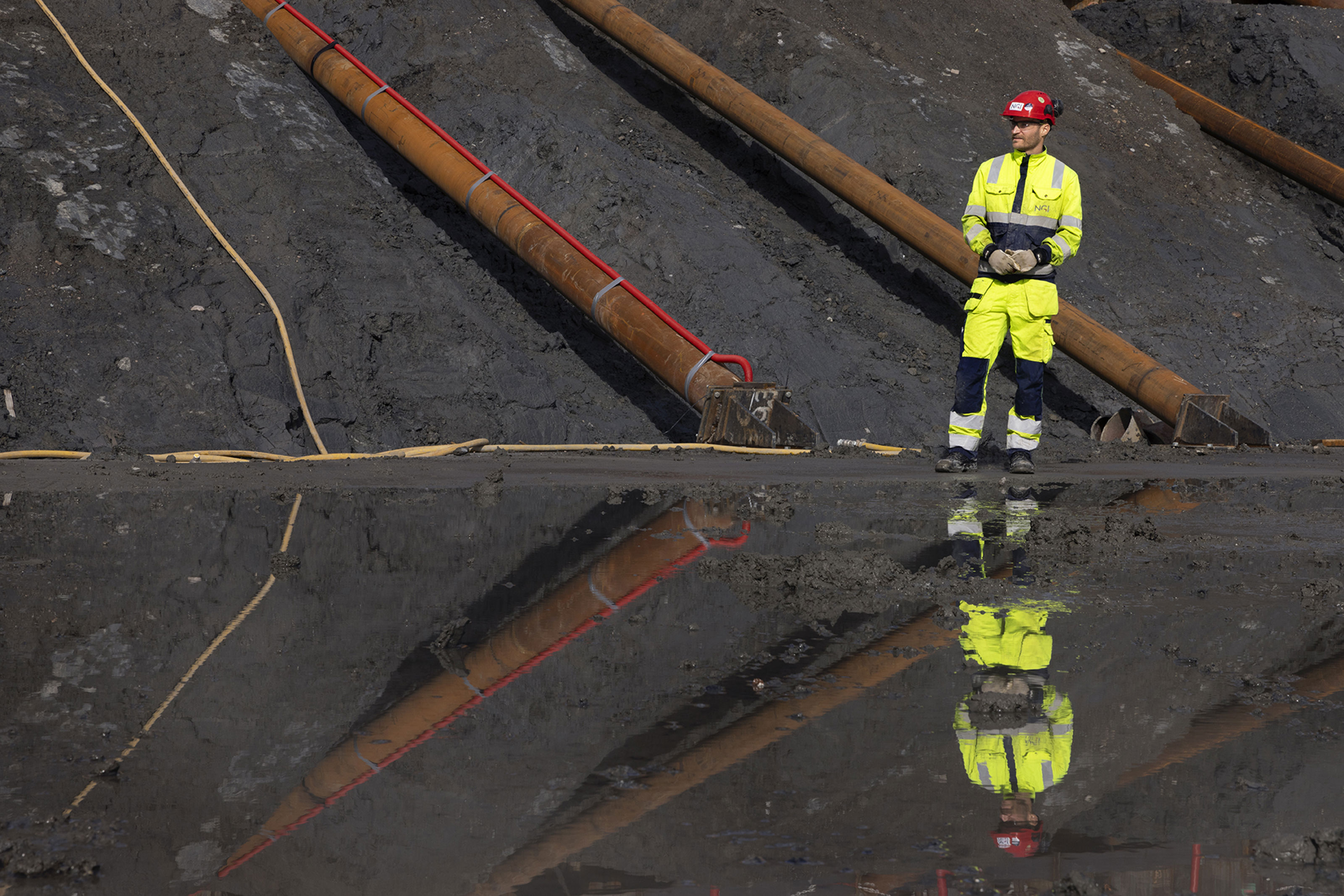Campus Ullevål shows that thorough ground investigations pay off
NGI – the Norwegian Geotechnical Institute – has carried out extensive ground investigations in connection with the construction of its new headquarters in Oslo, Campus Ullevål. Yet, these investigations account for less than 0.5 percent of the total building cost. The result: a smooth, innovative, and cost-efficient construction process, despite challenging ground conditions with quick clay.

NGI’s new headquarters, Campus Ullevål, is scheduled for completion in June 2026. Photo taken in November 2023. ( Photo: Mari Svenningsen)
In June 2026, NGI and other tenants will move in according to schedule – despite the fact that the building is located in an area with quick clay and surrounded by neighbouring buildings, roads, and infrastructure that had to be taken into account when two building blocks of seven and ten storeys, plus basements, were to be founded.
“Soft marine clay is a common and challenging soil condition in Norway, and not unusual in Oslo,” says NGI researcher Einar John Lande.

Senior Engineer Marit Skaug Løyland, NGI’s project manager for the construction project, at the building site in November 2023. ( Photo: Mari Svenningsen)
Construction and research hand in hand
Lande leads NGI’s research project CURIOUS – Campus Ullevål Research and Instrumentation Of Underground Structures. At Campus Ullevål, construction has been combined with instrumentation and monitoring of the excavation site.
“During excavation for the basement, we installed an extensive instrumentation program to monitor the performance of the retaining structures. These measurements have provided a basis for improving geotechnical design by developing more sustainable and cost-effective methods for construction in urban areas,” Lande explains.
The project has, among other things, tested new applications of fibre-optic sensing on steel sheet piles, recording how the piles stretch along their length during different excavation phases. A number of inclinometer channels have also been installed to measure tilt and horizontal deformation in the ground at various locations – outside the sheet pile wall, directly adjacent to it, and within the excavation in lime-cement stabilized soil.
“The research has enabled us to monitor and analyse the interaction between retaining structures and soil to a greater extent than before, and to study what actually happens within the ground improvement zone,” says Lande.

Senior Engineer Einar John Lande is project manager for NGI’s research project connected to the construction of Campus Ullevål. ( Photo: Mari Svenningsen)
58 boreholes – a key to success
A recurring theme in urban construction projects is cost overruns and delays, often caused by unforeseen ground conditions. To choose the right foundation solutions, NGI carried out an unusually large number of investigations before detailed design. Within the excavation footprint, 58 boreholes were drilled to interpret soil layering and map the depth to bedrock.
“That’s quite a dense grid of boreholes – and we found a significant amount of quick clay,” says Marit Skaug Løyland, project manager for NGI’s role as geotechnical designer for Campus Ullevål.
Raising the basement to avoid quick clay
The original plan was for a deeper basement. However, the investigations revealed extensive quick clay. This knowledge changed the design: the basement level was raised by 1.55 metres, avoiding excavation down to the quick clay layer. The adjustment reduced cost and risk of affecting adjacent properties.
“This insight would not have been possible without involving geotechnical consultants already before the pre-project phase. We carried out a cost analysis of different options and found that raising the basement level was clearly the best solution,” says Løyland.
The number of basement floors remained the same, but some ceiling heights were slightly adjusted.

Parts of the sheet pile wall and excavation pit for NGI’s new headquarters, as seen at the end of 2023. ( Photo: Mari Svenningsen)
Drained foundation slab reduced the number of piles
The construction site at Sognsveien 70 is surrounded by buildings, a busy road, and the metro line. Deep excavations and drilled piles in soft clay can lead to settlement damage to neighbouring structures.
The excavation was between 4 and 6.7 metres deep, with the groundwater level 1–2 metres below the surface – creating high uplift pressure on the basement slab.
“In recent decades, it has become common to use drilled steel-core piles grouted into bedrock,” says Løyland.
To minimise the risk of groundwater drainage along drilled piles – and potential settlement of neighbouring buildings – NGI and main contractor Skanska chose a more technically demanding but smarter solution: a drained foundation slab. This solution has only been used once before, in the deepest basement of the Oslo Opera House.
“Under the basement slab, we created a drained zone. Two pumps handle the daily water inflow of 30–60 litres. This approach reduced the number of piles from 598 to 369. In addition to avoiding potential settlement damage to nearby properties, the solution was far more cost-effective than the traditional steel-core pile method. By avoiding drilled piles, we also prevented groundwater drainage at bedrock level,” Løyland explains.
Instead of drilled steel cores, driven H-profile steel piles were used down to (and slightly into) bedrock. In areas with smaller loads, concrete piles were chosen. The detailed ground investigations provided a solid rock model, with estimated pile lengths and layouts.
“The contractor’s feedback has been excellent. The pile plan matched reality to the metre, resulting in more efficient progress,” says Løyland.
The total amount of steel used for the excavation works is around 1,900 tonnes – far less than originally planned.

Bracing from the sheet pile wall down toward the foundation slab in the excavation pit. ( Photo: Mari Svenningsen)
Strong collaboration on a challenging site
Skanska praises the cooperation on geotechnical design and investigations.
“The collaboration has been excellent, with close dialogue between NGI and Skanska Teknikk’s internal geotechnical engineers,” says Lasse Hyenes Lysne, Construction Manager for Structural Works at Campus Ullevål.
He explains that the foundation for the chosen solutions was extensive and detailed from the early project phases. The comprehensive investigations meant that Skanska was well prepared for the site’s challenges.
“We expected a demanding site based on the thorough investigations. In our tender, Skanska carried out internal design reviews to assess feasibility. For foundation and soil stabilization, we implemented the solutions described in the pre-project,” says Lysne.
During construction, several smaller adjustments were made in close dialogue with NGI to ensure correct quality and progress.
“In the tender, Skanska proposed a change to the execution of sheet piling, bracing, and excavation. This was developed by Skanska Teknikk and reviewed with NGI, who incorporated the revised method,” Lysne adds.
Among key lessons learned, Lysne highlights the importance of considering progress and practical implementation of groundworks already in the tender phase.
“Given the challenging ground conditions with quick clay and the site’s location, the cost-plus model between contractor and client was the right choice to avoid unnecessary risk premiums.”
The total cost of geotechnical work and investigations for Campus Ullevål amounts to around NOK 7.1 million, representing only about 0.5 percent of the total project cost of up to NOK 1.4 billion.

Sheet pile lock — the connection that locks the sheet piles together. ( Photo: Mari Svenningsen)
